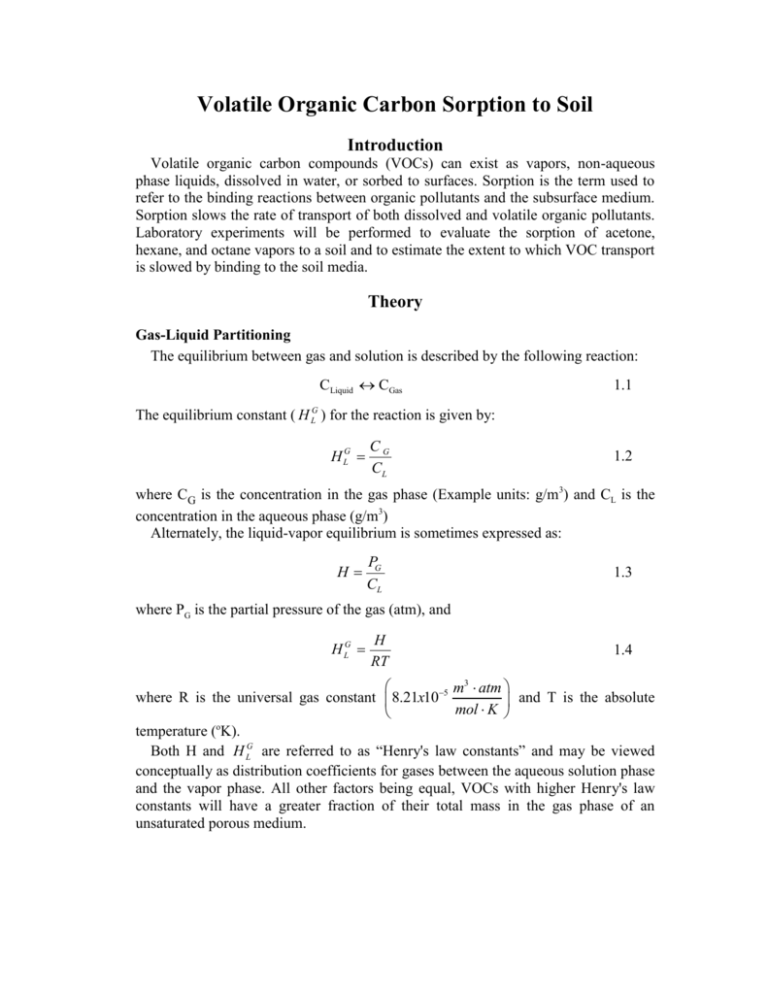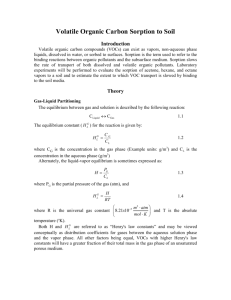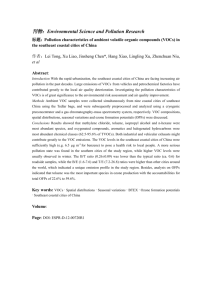Volatile Organic Carbon Sorption to Soil
advertisement

Volatile Organic Carbon Sorption to Soil Introduction Volatile organic carbon compounds (VOCs) can exist as vapors, non-aqueous phase liquids, dissolved in water, or sorbed to surfaces. Sorption is the term used to refer to the binding reactions between organic pollutants and the subsurface medium. Sorption slows the rate of transport of both dissolved and volatile organic pollutants. Laboratory experiments will be performed to evaluate the sorption of acetone, hexane, and octane vapors to a soil and to estimate the extent to which VOC transport is slowed by binding to the soil media. Theory Gas-Liquid Partitioning The equilibrium between gas and solution is described by the following reaction: CLiquid CGas 1.1 The equilibrium constant ( H LG ) for the reaction is given by: H LG CG CL 1.2 where CG is the concentration in the gas phase (Example units: g/m3) and CL is the concentration in the aqueous phase (g/m3) Alternately, the liquid-vapor equilibrium is sometimes expressed as: H PG CL 1.3 where PG is the partial pressure of the gas (atm), and H LG H RT 1.4 m3 atm where R is the universal gas constant 8.21x105 and T is the absolute mol K temperature (oK). Both H and H LG are referred to as “Henry's law constants” and may be viewed conceptually as distribution coefficients for gases between the aqueous solution phase and the vapor phase. All other factors being equal, VOCs with higher Henry's law constants will have a greater fraction of their total mass in the gas phase of an unsaturated porous medium. Liquid-Solid Partitioning The sorption of organic pollutants that are dissolved in water onto soils and aquifer materials also may be described in many cases by a distribution coefficient ( K LS ): K LS CL 1.5 where is the mass of solute sorbed per mass of solid. Equation 1.5 predicts that the amount of pollutant bound to the soil () will increase linearly with the concentration in the aqueous phase (CL). Any relationship between the amount bound to the soil and the concentration in solution applies at a constant temperature and is referred to as an “isotherm.” Equation 1.5 is an example of a “linear isotherm.” The success of the linear isotherm in describing sorption of nonionic organic pollutants in saturated soils has been remarkable. Linear isotherms have been found to describe sorption of a wide array of nonionic compounds onto sediments and soils (Karickhoff et al. 1979, Chiou et al. 1979). Many investigations have demonstrated that the distribution coefficient ( K LS ) for sorption of a single organic contaminant onto a variety of soil materials can be related to the organic content of the sorbent. This observation permits the definition of an organic normalized partitioning coefficient (Koc): K oc K LS f oc 1.6 where foc is the weight fraction of organic carbon in the soil. Koc values for a range of different organic compounds have been shown to be related to their octanol-water partitioning coefficients (Kow) and also to their aqueous solubilities (Karickhoff, 1984). An important implication of these results is that sorptive distribution coefficients of organic pollutants in water saturated aquifers ( K LS ) may be predicted given knowledge of the organic content of the soil (foc) and the octanol-water partitioning coefficient (Kow) of the contaminant or a related parameter such as its aqueous solubility. Gas-Solid Partitioning Sorption of gases is frequently described using the classic equation developed by Brunauer, Emmett and Teller (1938), i.e., the BET equation: B M P0 P P0 P B P0 P0 1.7 where is the amount of sorbed gas per unit of surface (with units such as moles/m 2 or µg/g if the surface area is not known), M is the amount of sorbed gas corresponding to monolayer surface coverage, P is the partial pressure of the sorbed gas, Po is its saturated vapor pressure, and B is a parameter related to solute binding intensity; more specifically: v kT B e 1.8 where is the energy of the adsorbate vapor-adsorbent surface interaction (cal/mole), v is the vaporization energy of the organic (cal/mole), k is the Boltzmann constant, and T is the absolute temperature (oK). To the extent that it is valid in soil, the BET equation predicts vapor sorption isotherms to be nonlinear. Nonlinear isotherms have been observed for sorption of organic vapors onto dry soils at high vapor concentrations by several investigators (Chiou, 1990; Rhue, et al., 1988; and Ong and Lion, 1991c). Under conditions of low vapor pressure, P << Po, the BET equation reduces to: B M P0 P B 1.9 which is the “Langmuir adsorption equation” that applies to monolayer limited adsorption. The BET equation further reduces to a linear isotherm when B << (Po/P). P B M P0 1.10 Error! Reference source not found. A Linear illustrates linear, BET Langmuir and BET isotherms that share a Langmuir common set of B and m values. Linear sorption isotherms for P/Po vapors are a reasonable B expectation at low vapor concentrations (Ong and Lion, 1991a). BET At higher vapor Langmuir concentrations, surface site limitations and the phenomenon of vapor P/Po condensation at the surface (for which the Figure 1. Linear, Langmuir and BET sorption isotherms BET model attempts to for the case where m = 10,000 and B = 1,000. A) account) will result in Isotherms for P/Po < 0.3. B) Isotherms for P/Po up to 1.0. nonlinear VOC sorption 20 000 16 000 12 000 80 00 B = 1,00 0 ma x = 10 ,000 40 00 0 0.0 0.1 0.2 0.3 300 000 200 000 100 000 0 0.0 0.2 0.4 0.6 0.8 1.0 isotherms. Results obtained at Cornell (Ong et al., 1991; Ong and Lion, 1991c) have confirmed that condensation of organic vapors will occur at high vapor pressures in moist porous media. Condensed water and organic vapors compete for the available pore space. Since soils are generally wet prior to the introduction of organic contaminants, vapor condensation is expected to be limited to the pore volume not occupied by water. The extent to which organic vapor condensation is significant will, therefore, be a function of the soil moisture content, and the relative vapor concentration (P/P0). Since the unsaturated zone in an aquifer will typically contain condensed water, description of the sorption of organic vapors in the unsaturated zone must, at a minimum, consider a binary mixture of the organic and water vapor. The organic vapor of concern may accumulate in the unsaturated zone through at least three processes: (a) by direct sorption from the vapor phase, including vapor sorption to dry mineral surfaces (if present), vapor sorption at the gas-water interface, and vapor condensation, (b) by solubilization in condensed pore water as governed by Henry's Law (equation 1.2 or 1.3), and (c) by sorption from condensed pore-water solution onto the soil (as governed by equation 1.5). Since, at very low vapor pressures, a linear isotherm is expected to govern vapor sorption, we may write a linear isotherm in terms of the gas concentration: KGS CG 1.11 where the magnitude of K GS depends on the sorbent’s moisture content. The relative contributions to of processes such as vapor dissolution into soil moisture and sorption at the liquid-air interface can be assessed through the use of a mass balance. The total mass of vapor sorbed onto the soil, under equilibrium conditions, can be viewed as being distributed between: (Mass sorbed at the solid-liquid interface) + (Mass dissolved in the liquid phase) + (Mass sorbed at liquid-air interface + condensation) = M s =X +CLVL + 1.12 where Ms is the mass of the sorbent (soil or other porous media) and is a lumped parameter that includes the effects of water surface sorption and condensation. From equation 1.5 for liquid-phase sorption: X K LS M S CL where = X/Ms and Ms is the mass of the sorbent. Also, from Henry's Law: CG H Lg CL . Substituting these two relationships and equation 1.11 into equation 1.12 gives: KGS K LS VL G G H L M S H L CG M S 1.13 If the density of water on the soil surface is expressed as H 2O M H 2O / VL , the M H 2O term VL/Ms becomes M s H O 2 . Assuming water surface sorption and condensation are negligible ( ≈ 0), then for high moisture content equation 1.13 will plot as a straight line, with the ordinate intercept equal to the contribution of aqueous phase sorption to vapor-phase partitioning ( K LS / H LG ). KGS K LS Moisture Content % H LG 100 H LG 1.14 Equation 1.14 indicates that the linear vapor distribution coefficient, K GS , can be predicted from the saturated distribution coefficient and the Henry’s law constant for a given VOC. Experiments by Ong and Lion (1991a) have shown that such predictions are reasonable as long as the moisture content of the soil is high enough to ensure that the VOC that is dissolved in sorbent-bound water behaves as if the liquid were comparable to the water in a bulk aqueous phase. In general, a moisture content equivalent to an average surface coverage of ≈ 5 layers of water molecules is adequate for this assumption to be obeyed (Ong and Lion, 1991a). Many soil ambient moisture contents are in excess of this limiting value. Pollutant Transport in Porous Media The advective dispersion equation is used to describe pollutant movement in porous media. For one-dimensional (ex., horizontal) transport of a conservative ( K LS 0 ) pollutant: C C 2C -U E 2 1.15 t x x where t is time, x is distance, U is the groundwater pore velocity and E is the macroscopic dispersion coefficient (Freeze and Cherry, 1979). Since volatile organic pollutants react with the surfaces of the porous media through which the contaminant flows, equation 1.15 must be modified to account for b the sorption reaction by addition of the term: where b is the bulk density of t the porous medium (g/cm3), and is the volumetric moisture content (volume of liquid per unit bulk volume of the porous medium). is equal to the porosity, , in a saturated porous medium. b C K LS . From the chain rule, b and for a linear isotherm, C t C t Therefore, the advection-dispersion equation for a compound that experiences sorptive binding to the soil matrix becomes: C C 2 C b K LS C = -u +E 2 t x x t F G H IJ K C KS C 2 C 1+ b L = -u +E 2 t x x The retardation factor, R, for a pollutant in soil is defined as: 1.16 1.17 KS 1.18 R 1+ b L Therefore the advective dispersion equation modified for sorptive binding becomes: C -u C E 2 C 1.19 = + t R x R x 2 From equation 1.19 it is apparent that the velocity and dispersion of a sorbed compound will be reduced by the magnitude of retardation factor, R. So, R= pore water velocity 1 contaminant velocity 1.20 Note that R may be determined directly from knowledge of the medium properties ( b and ) and from the distribution coefficient for sorption ( K LS for water saturated media or K GS for a vapor). Interestingly, equation 1.19 may also be applied to describe vapor movement in a gas chromatograph (GC). GC columns are selected to ensure that the components of a vapor mixture will be separated (by virtue of their different retardation factors) by the time they arrive at the GC detector (situated at the end of the column). In the absence of pressure gradients, transport of vapors will occur primarily through the process of diffusion and equation 1.19 reduces to: Es 2 C C t Ebulk x 2 1.21 where Es is the effective diffusion coefficient of the VOC in the porous media. Vapor diffusion coefficients in unsaturated porous media are different from those in a bulk gas phase because the vapor must follow a tortuous path to move through the open pores. The relationship proposed by Millington and Quirk (1961) is commonly used to correct vapor diffusion coefficients for the conditions in the soil media. Es a10 / 3 2 Ebulk 1.22 where Ebulk is the vapor diffusion coefficient in air, a is the volumetric air content of the porous medium (volume of gas per unit bulk volume of medium), and is the porosity (a + = ). Analysis of the Unsaturated Distribution Coefficient ( K GS ) A mass balance calculation will be used to determine the unsaturated vapor distribution coefficient ( K GS ). After equilibration the VOC mass will be distributed between the vapor phase and the solid phase (sorbed VOC). MVOC =CGVG +M s 1.23 where M s is the mass of sorbed VOC and equals K GS M S CG (from equation 1.11). In control bottles there is no sorbent so the VOC mass must reside entirely in the vapor phase: M VOCUC = CGUC VGUC 1.24 where the subscript uc indicates that volumes and concentrations are those measured in the unsaturated control bottles. Setting equations 1.23 and 1.24 equal to one another (the mass of VOC was the same for all vials) and rearranging gives: MVOCUC = CGVG KGS M S CG 1.25 Solving for K GS KGS M VOCUC CGVG M S CG 1.26 Using the measured soil moisture contents and values of K GS , students may check the validity of equation 1.14. Unsaturated Mass Fraction Distribution The total mass of the VOC is distributed between the gas and sorbed phases (equation 1.23). 1=ƒG +ƒ S 1.27 where ƒG is the fraction of the VOC mass in the gas phase and ƒ S is the fraction of the VOC mass sorbed to the soil. The relationship between the fraction of VOC in each phase is obtained from the definition of the unsaturated distribution coefficient (equation 1.11). ƒS KSM = G S ƒG VG 1.28 Thus we have two equations in two unknowns. Solving we obtain ƒG = 1 KSM 1 G S VG 1.29 ƒS = 1 V 1 S G KG M S 1.30 where VG =Vvial MS soil 1.31 Determination of K GS requires a measurement of the fraction sorbed given measurements of the total mass added and the mass in the gas phase. This analysis becomes inaccurate as the magnitude of ƒ S decreases and approaches the coefficient of variation of M VOCUC . Analysis of the Saturated Distribution Coefficient ( K LS ) A mass balance calculation will be used to determine the saturated vapor distribution coefficient ( K LS ). The calculation assumes that students can reproduce the introduction of the mass of VOC (MVOC) into each sample bottle. After equilibration the VOC mass can be distributed between the vapor phase the aqueous phase and the solid phase (sorbed VOC). MVOC = CGVG +CLVL + M S 1.32 where Ms is the mass of sorbed VOC and equals K LS CL M S (from equation 1.5). In saturated control bottles there is no sorbent so the VOC mass must just be distributed between the vapor phase and the aqueous phase: M VOCSC =CGSC VGSC +CLSC VLSC 1.33 where the subscript sc indicates that volumes and concentrations are those measured in the control bottles. Henry’s law (equation 1.2) can be used to eliminate C Lsc . VL MVOCSC =CGSC VGSC SCG 1.34 HL Equation 1.34 can be used to obtain an estimate of Henry’s law constant by assuming that the mass of VOC added is the same for the vials with and without water. Solving for H LG and substituting M VOCUC for M VOCSC we obtain: H LG = VLSC CGSC MVOCUC VGSC CGSC 1.35 Equation 1.32 can now be used to obtain an estimate of K LS . The mass of VOC added to the bottles was the same for all vials. Thus ( M VOC ) in equation 1.32 is equal to M VOCSC . In addition, CL and CG are interrelated through Henry’s law (equation 1.2 ). Substituting into equation 1.32 gives: MVOCsc =CGVG + CG C V + M S K SL GG G L HL HL 1.36 Solving for K LS CG 1.37 MVOCsc CGVG G VL H L Measured VOC headspace concentrations are substituted into equation 1.37. Values for Henry’s law constants are given in Table 1. M VOCSC is obtained from equation 1.34. In vials containing soil, VG is determined by subtracting both VL (50 mL) and the volume of the sorbent from the total vial volume. The volume of the sorbent may be calculated from the sorbent weight and density as: K LS H LG M S CG Vsoil Ms 1.38 soil It is instructive to calculate the phase distribution of each VOC in bottles that contain no soil. The fraction (ƒ) of VOC mass in the gas phase is given by f= CGVG VG = CGVG CLVL V VL G 1.39 H LG Assuming the total volume of the bottle is 120 mL and 50 mL of liquid are added, then f= 70 70 50 1.40 H G L ƒ values for octane, acetone, and toluene are therefore 0.994, 0.009, and 0.278 respectively indicating that only toluene has a significant mass fraction in both the gas and aqueous phases. In the absence of strong sorption by soil, octane will reside primarily in the gas phase and acetone will reside primarily in the aqueous phase. Determinations of K LS for these two compounds may therefore not be feasible using the headspace technique. Saturated Mass Fraction Distribution The total mass of the VOC is distributed between the gas, sorbed, and liquid phases (equation 1.32). 1=fG +f S +f L 1.41 where f L is the fraction of the VOC mass in the liquid phase. The relationship between the fractions of VOC in the solid and liquid phases is obtained from the definition of the saturated distribution coefficient (equation 1.5). fS KSM = L S fL VL 1.42 The relationship between the fractions of VOC in the gas and liquid phases is obtained from the definition of the Henry’s law constant (equation 1.2). fG H LG VG = fL VL 1.43 Thus we have three equations in three unknowns. Solving we obtain VL VL K M S +H LGVG 1.44 fS = K LS M S VL +K LS M S +H LGVG 1.45 fG = H LGVG VL +K LS M S +H LGVG 1.46 fL = S L where VG = Vvial VL MS S 1.47 Determination of K LS requires a measurement of the fraction sorbed given measurements of the total mass added, the mass in the gas phase, and knowledge of the Henry’s law constant. This analysis becomes inaccurate when ƒS decreases and approaches the coefficient of variation of M VOCSC . Experimental procedures VOC distribution coefficients will be determined using crimp top vials sealed with Teflon backed septa and aluminum crimp caps. VOCs will be analyzed by students using a gas chromatograph (GC). A data table for preparation of the necessary vials is shown in Table 4. The data table is also available in spreadsheet form as “isotherm calculator.” Analysis of the Unsaturated Distribution Coefficient ( K GS ) The distribution coefficient for three VOCs (acetone, octane, and toluene) with the unsaturated soil medium ( K GS ) will be determined using the headspace method of Peterson et al. (1988). Students will prepare 120 mL vials (actually 121.5 ± 0.5 mL) in triplicate containing 0 and 20 g of moist soil (6 vials total). The weight of replicates need not be precisely matched, but the weight of soil should be measured accurately. Seal the vials using Teflon-backed septa (the shiny Teflon side faces the vial contents) and aluminum crimp cap. The 3 VOCs are added to the vials by introduction of 1 mL of the saturated vapor taken from the headspace of “source vials” (crimp capped vials containing liquid octane, toluene, and acetone). Use a dedicated syringe for each VOC and leave dedicated needles in the source bottles. The vials should be placed on a wrist action shaker to continue agitation for ≥ 30 minutes to permit the VOC time to sorb to the soil medium. After equilibration, vials are removed from the wrist action shaker and the head space sampled using a 500 µL gas tight syringe. Use the syringe technique as described previously for sampling vial headspace. Analysis of the Saturated Distribution Coefficient ( K LS ) The saturated distribution coefficient ( K LS ) for three VOCs (acetone, octane, and toluene) with the soil medium will be determined using the headspace method of Garbarini and Lion (1985) as modified by Peterson et al. (1988). These vapors are selected to demonstrate the effect of VOC Henry's law constant on VOC phase distribution (see Table 1). Students will prepare 120 mL vials (actually 121.5 ± 0.5 mL) in triplicate containing 0 and 20 g of potting soil (6 vials total). The weight of replicates need not be precisely matched, but the weight of soil should be measured accurately. Soil density should be separately measured as described below. If moist soil is used students should also determine the dry weight unless the instructor provides this information (see below). Into each vial students will add 50 mL of tap water. Seal the vials using a Teflon-backed septa (the shiny Teflon side faces the vial contents) and aluminum crimp cap. Octane and toluene are then added to the vials by introduction of 1 mL of the saturated vapor taken from the headspace of “source vials” (crimp capped vials containing liquid octane and toluene). Use different needles for collecting and delivering the VOC to reduce the transfer of VOC on the needles. The needle used to collect the VOC from the source bottle can be left in the source bottle and simply attached to the syringe when needed. Acetone is added by introduction of 200 µl of the liquid compound using a gas tight syringe. The vials should be placed on a wrist action shaker to continue agitation for ≥ 30 minutes to permit the VOC time to sorb to the soil medium. After equilibration, vials are removed from the wrist action shaker and the head space sampled using a 500 µL gas tight syringe. To sample the vial headspace, use a 100 L sample and the syringe technique described previously. Procedure (short version) 1) 2) 3) 4) Weigh soil and add to isotherm vials (6 vials with 20 g). Add 50 mL tap water to 6 vials (3 each with 0 and 20 g soil). Seal 12 vials. Add octane, toluene, and acetone to all vials (1 mL gas from source vials for all VOC’s except 200 µL liquid acetone for vials with tap water). 5) Place vials on shaker for 30 minutes. “Calibrate” GC by analyzing 4 100-L samples for each VOC. Take vials off of shaker. Measure VOC concentrations for each vial and record peak areas in spreadsheet. Reanalyze the VOC concentrations for any vials for which anomalous data was obtained. 10) Remove vial caps. 11) Pour waste potting soil into designated container. 12) Wash vials. 6) 7) 8) 9) Prelab Questions 1) Why does the determination of K GS become inaccurate as the magnitude of ƒS decreases and approaches the coefficient of variation of M VOCUC ? 2) What conditions are necessary to obtain linear isotherms for gas/solid partitioning of organic vapors? 3) When can equation 1.14 be used to predict the relationship between liquid/solid partitioning and gas/solid partitioning based on soil moisture content and Henry’s law constant? Data Analysis A Note on Units Express mass of VOC in grams (as measured by the GC). Express concentrations in g/mL. Remember to account for the fact that the syringe volume for GC analysis is 100 µL Express all volumes in mL. 1) Estimate the mass of each VOC added to the unsaturated sample vials based on M VOCUC (from equation 1.24). Report mean and coefficient of variation (standard deviation/mean) for each VOC. 2) Calculate the unsaturated vapor distribution coefficient ( K GS ) using equation 1.26. Report a single mean and coefficient of variation for each VOC. 3) Calculate the mass fraction associated with the soil and gas phases under unsaturated conditions for each of the VOCs. Use equations 1.29, 1.30, and 1.31. Assume Ms = 20 g and bottle volume is 121.5 mL. Use the average K GS calculated in 2 above. Compare the coefficient of variation of M VOCUC to the mass fractions to evaluate which K GS determinations are potentially accurate. Create a stacked bar graph of the mass fractions for each VOC. 4) Estimate the Henry’s law constant ( H LG ) for octane and toluene using equation 1.35 (different masses of acetone were used for the saturated and unsaturated vials and thus equation 1.35 can not be used for acetone). Report mean and coefficient of variation. Compare your results to the Henry’s law constants reported in the table on page Error! Bookmark not defined.. 5) Estimate the mass of each VOC added to the saturated sample vials based on M VOCSC (from equation 1.34) using tabulated Henry’s constants (see table on page Error! Bookmark not defined.). Report mean and coefficient of variation for each VOC. 6) Calculate the saturated vapor distribution coefficient ( K LS ) using equation 1.37. Report a single mean and coefficient of variation for each VOC. Use tabulated Henry’s constants reported in the table on page Error! Bookmark not defined.. 7) Calculate the mass fraction associated with the soil, gas, and water phases under saturated conditions using equations 1.44 - 1.47. Assume Ms = 20 g, VL = 50 mL, and bottle volume is 121.5 mL. Use the average calculated K LS and the Henry’s law constants reported in the table on page Error! Bookmark not defined.. Compare the coefficient of variation of M VOCSC to the mass fractions to evaluate which K LS determinations are potentially accurate. Create a stacked bar graph of the mass fractions for each VOC. 8) Calculate K GS for toluene using equation 1.14 and compare with the measured value of K GS . 9) Assuming a typical soil porosity () of 0.33 and bulk density (b) of 1.7 g/cm3, equation 1.18 may be used to calculate the retardation of dissolved VOCs and VOC vapors. Assuming a pore water velocity of 1 m/day, how long will it take for the dissolved toluene to be transported a distance of 100 m? Include a range of the estimate based on 1 standard deviation. 10) If toluene is removed by withdrawing vapor at a velocity of 100 m/day, how long will it take toluene vapor to travel 100 m? [Note in this case K GS replaces K LS and a replaces in equation 1.18. Assume the soil voids are filled with gas so a = = 0.33.] Include a range of the estimate based on 1 standard deviation. 11) Discuss how the results of this experiment would guide you in remediating a site contaminated with toluene, acetone, and, octane. References Brunauer, S., P.H. Emmett and E. Teller, "Adsorption of Gases in Multimolecular Layers", J. Amer. Chem. Soc., 60, p. 309, 1938. Chiou, C.T., L.J. Peters and J.H. Freed, "A Physical Concept of Soil-Water Equilibria For Nonionic Organic Compounds", Science, 206, p. 831, 1979. Chiou, C.T., "Roles of Organic Matter, Minerals and Moisture in Sorption of Nonionic Compounds and Pesticides by Soils", in Humic Substances in Soil and Crop Sciences; Selected Readings, P. MacCarthy, C.E. Clapp, R.L. Malcolm and R.R. Bloom (Eds.), Am. Soc. of Agron. & Soil Sci. Soc. of Am, Madison, WI, pp. 111-160, 1990. Freeze, R.A. and J.A. Cherry; Groundwater, Prentice Hall, Inc.; Englewood Cliffs, NJ, 604 pp., 1979. Karickhoff, S.W., D.S. Brown and T.A. Scott, "Sorption of Hydrophobic Pollutants on Natural Sediments", Water Res., 13, p. 241-248, 1979. Karickhoff, S.W., "Organic Pollutant Sorption in Aquatic Systems", J. Hydraulic Engrg., 110(6), p. 707, 1984. Millington, R.J., J.M. Quirk, “Permeability of porous solids”, Trans. Faraday Soc. 57, p. 1200-1207, 1961. Ong, S.K., and L.W. Lion, "Sorption Equilibria and Mechanisms for Trichloroethylene onto Soil Minerals", J. Env. Qual., 20(1), p. 180-188, 1991a. Ong, S.K., and L.W. Lion, "Effects of Soil Properties and Moisture on the Sorption of TCE Vapor", Water Resources Research, 25(1), p. 29-36, 1991b. Ong, S.K., and L.W. Lion, "Trichloroethylene Vapor Sorption onto Soil Minerals at High Relative Vapor Pressure", Soil Sci. Soc. Am. J., 55(6), p. 1559-1568, 1991c. Ong, S.K., S.R. Lindner and L.W. Lion, "Applicability of Linear Partitioning Relationships for Organic Vapors onto Soil Minerals", in: Organic Substances and Sediments in Water, R.A. Baker (Ed.), Lewis Publ., Chelsea, MI, pp. 275-289, 1991. Rhue, R.D., P.S.C. Rao and R.E. Smith, "Vapor Phase Adsorption of Alkylbenzenes and Water on Soils and Clays", Chemosphere, 17, p. 727-741, 1988. Additional References Relevant to Data Reduction Garbarini, D.R. and L.W. Lion, “Evaluation of sorptive partitioning of nonionic organic pollutants in closed systems by headspace analysis,” Env. Sci. & Tech., 19(11), 1122-1128 (1985). Gossett, J.M. “Measurement of Henry's law constants for C1 and C2 chlorinated hydrocarbons,” Env. Sci. & Tech., 21(2), 202 (1987). Peterson, M.S., L.W. Lion, and C.A. Shoemaker, “Influence of vapor phase sorption and diffusion on the fate of trichloroethylene in an unsaturated aquifer system.” Env. Sci. & Tech. 22(5), 571-578, (1988). Symbol List Symbol H LG Definition Henry’s Constant K LS Liquid/solid partitioning coefficient K GS Gas/solid partitioning coefficient B C E f k Koc Solute binding intensity Concentration Dispersion coefficient Mass fraction Boltzmann constant Liquid/organic carbon partitioning coefficient octanol-water partitioning coefficients Mass Partial pressure Saturated vapor pressure Universal gas constant Retardation factor o Absolute Temperature( K). Temperature Time Groundwater pore velocity Volume Mass sorbed at the solid-liquid interface Distance Mass of solute sorbed per mass of solid vapor-adsorbent surface interaction vaporization energy of the organic Kow M P P0 R R T T t U V X x v Porosity Volumetric moisture content Density of water Mass sorbed at liquid-air interface + condensation Subscript b G L M oc S sc uc VOC Definition Bulk Gas phase Aqueous phase Monolayer Organic carbon Soil phase or sorbent Saturated control Unsaturated control Volatile organic carbon Lab Prep Notes For equipment list and gas chromatograph method see page Error! Bookmark not defined.. Table 1. Reagents list Description Source Catalog number 03008-1 O299-1 T324-500 Setup Octane Fisher Scientific Acetone Fisher Scientific 1) Replace injection port septa on all toluene Fisher Scientific GC’s. Potting soil Agway (remove 2) Verify that GC’s are working large particles by screening to properly by injecting gas samples 2 mm) from each VOC source bottle. If the baseline is above 30 (as read on the computer display) then heat the oven to 200°C to clean the column. 3) Verify that sufficient gas is in the gas cylinders (hydrogen, air, nitrogen). 4) Verify that sufficient vials/aluminum crimp tops and Teflon seals are available. 5) Prepare VOC source vials that contain liquid acetone, octane, and toluene (they can be shared by two groups of students). 6) Fill repipet dispensors with tap water and place on each lab bench. Table 2. Each group of students requires the following syringes Octane (gas) Toluene (gas) Acetone (gas) Acetone (liquid) Source vial (gas) Isotherm (gas) 1 mL 1 mL 1 mL 0.5 mL 0.5 mL 0.5 mL Syringe clean up Disassemble and heat syringes to 45°C overnight to remove residual VOCs. Place syringe barrels upside down on top of openings above fan in oven to facilitate mass transfer.









